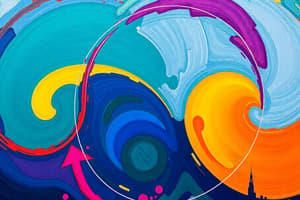Podcast
Questions and Answers
Which type of unemployment is caused by individuals transitioning between jobs?
Which type of unemployment is caused by individuals transitioning between jobs?
- Structural unemployment
- Seasonal unemployment
- Frictional unemployment (correct)
- Cyclical unemployment
How does the government impact the circular flow of income?
How does the government impact the circular flow of income?
- Through taxation and public spending. (correct)
- By directly producing goods and services for households.
- By solely providing loans to households.
- By managing the prices of all goods sold in the economy.
What role do firms play in the circular flow of income model?
What role do firms play in the circular flow of income model?
- They facilitate international trade transactions.
- They provide labor and receive dividends.
- They produce goods and services using factors of production. (correct)
- They collect taxes and distribute public goods.
What differentiates nominal GDP from real GDP?
What differentiates nominal GDP from real GDP?
What causes demand-pull inflation?
What causes demand-pull inflation?
Which statement accurately describes the function of financial institutions in the circular flow of income?
Which statement accurately describes the function of financial institutions in the circular flow of income?
What is a primary tool used in monetary policy?
What is a primary tool used in monetary policy?
How does cyclical unemployment primarily occur?
How does cyclical unemployment primarily occur?
Flashcards are hidden until you start studying
Study Notes
Macroeconomics Overview
- Macroeconomics studies the economy as a whole, focusing on aggregate indicators and their interrelationships.
- Key objectives include understanding economic growth, employment levels, inflation rates, and overall economic stability.
Circular Flow of Income
-
Definition: The circular flow of income is a model that illustrates how money moves through the economy.
-
Key Components:
- Households: Provide factors of production (labor, capital) and receive income (wages, rents, dividends).
- Firms: Use factors of production to produce goods and services, which are sold to households.
- Government: Collects taxes from households and firms, provides public goods and services.
- Financial Institutions: Facilitate the flow of funds, savings, and investments in the economy.
- Foreign Sector: Involves trade (exports and imports) affecting domestic income.
-
Flow of Income:
- Households receive income from firms in exchange for labor and services.
- Households spend this income on goods and services from firms, creating a continuous cycle.
- The government injects money through public spending and withdraws money via taxation.
Basic Concepts in Macroeconomics
-
Gross Domestic Product (GDP): The total monetary value of all finished goods and services produced within a country's borders in a specific time frame.
- Nominal GDP: Measured at current market prices.
- Real GDP: Adjusted for inflation, providing a more accurate reflection of economic performance over time.
-
Unemployment Rate: The percentage of the labor force that is jobless and actively seeking employment.
- Types of unemployment include:
- Frictional: Short-term, transitional unemployment.
- Structural: Mismatch of skills and jobs available.
- Cyclical: Caused by economic downturns.
- Types of unemployment include:
-
Inflation Rate: The rate at which the general level of prices for goods and services rises, eroding purchasing power.
- Demand-Pull Inflation: Caused by an increase in demand outpacing supply.
- Cost-Push Inflation: Driven by rising costs of production.
-
Monetary Policy: The process by which a central bank controls the money supply and interest rates to achieve economic goals.
- Tools include:
- Open market operations
- Discount rate adjustments
- Reserve requirements
- Tools include:
-
Fiscal Policy: Government spending and tax policies used to influence economic conditions.
- Expansionary fiscal policy: Increased spending or tax cuts to stimulate the economy.
- Contractionary fiscal policy: Decreased spending or tax increases to cool down an overheated economy.
-
Business Cycle: The fluctuations in economic activity characterized by periods of expansion and contraction.
- Phases include:
- Expansion: Increasing economic activity.
- Peak: Maximum output before a downturn.
- Contraction: Decrease in economic activity.
- Trough: Lowest point before recovery.
- Phases include:
Macroeconomics Overview
- Studies the economy on a large scale, analyzing aggregate indicators and their interconnections.
- Key objectives include: economic growth, employment rates, inflation, and maintaining overall economic stability.
Circular Flow of Income
- Definition: A model demonstrating the flow of money within the economy.
- Key Components:
- Households: Supply labor and capital, receiving wages, rents, and dividends in return.
- Firms: Utilize production factors to create goods/services for households.
- Government: Gathers taxes and provides public goods/services to maintain economic welfare.
- Financial Institutions: Enable the circulation of funds, savings, and investments.
- Foreign Sector: Engages in trade (exports/imports), influencing domestic income levels.
- Flow of Income:
- Income flows from firms to households for labor, leading to household spending on goods/services from firms.
- Government injects money into the economy through public spending, while taxes withdraw income.
Basic Concepts in Macroeconomics
- Gross Domestic Product (GDP): Total value of all finished goods/services produced domestically over a certain period.
- Nominal GDP: Measurement based on current market prices.
- Real GDP: Adjusted for inflation, providing a clearer picture of economic performance.
- Unemployment Rate: Represents the percentage of the labor force that is jobless yet actively seeking work.
- Types of Unemployment:
- Frictional: Temporary phases between jobs.
- Structural: Occurs when there is a mismatch between skills and job opportunities.
- Cyclical: Results from economic downturns affecting job availability.
- Types of Unemployment:
- Inflation Rate: Indicates how quickly prices for goods/services rise, diminishing purchasing power.
- Types of Inflation:
- Demand-Pull: Results from demand exceeding supply.
- Cost-Push: Caused by increased production costs.
- Types of Inflation:
- Monetary Policy: Central bank's management of money supply and interest rates to achieve economic objectives.
- Key tools: open market operations, discount rate adjustments, reserve requirements.
- Fiscal Policy: Government use of spending and taxation to influence the economy.
- Expansionary Fiscal Policy: Spending increases or tax reductions to boost the economy.
- Contractionary Fiscal Policy: Spending cuts or tax increases to reduce economic overheating.
- Business Cycle: Economic activity variations marked by expansion and contraction phases.
- Phases:
- Expansion: Growth in economic activity.
- Peak: Highest output before decline.
- Contraction: Reduction in economic activity.
- Trough: Lowest point prior to recovery.
- Phases:
Studying That Suits You
Use AI to generate personalized quizzes and flashcards to suit your learning preferences.




